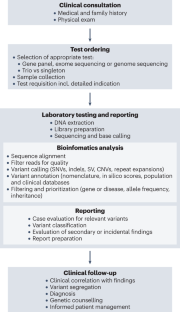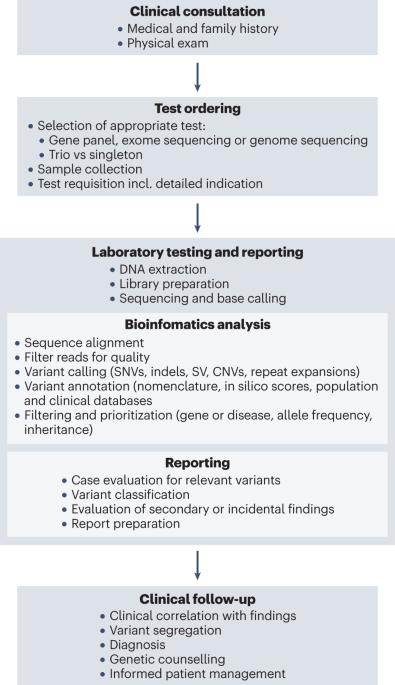The expanding diagnostic toolbox for rare genetic diseases
IF 39.1
1区 生物学
Q1 GENETICS & HEREDITY
引用次数: 0
Abstract
Genomic technologies, such as targeted, exome and short-read genome sequencing approaches, have revolutionized the care of patients with rare genetic diseases. However, more than half of patients remain without a diagnosis. Emerging approaches from research-based settings such as long-read genome sequencing and optical genome mapping hold promise for improving the identification of disease-causal genetic variants. In addition, new omic technologies that measure the transcriptome, epigenome, proteome or metabolome are showing great potential for variant interpretation. As genetic testing options rapidly expand, the clinical community needs to be mindful of their individual strengths and limitations, as well as remaining challenges, to select the appropriate diagnostic test, correctly interpret results and drive innovation to address insufficiencies. If used effectively — through truly integrative multi-omics approaches and data sharing — the resulting large quantities of data from these established and emerging technologies will greatly improve the interpretative power of genetic and genomic diagnostics for rare diseases. Genomic technologies have greatly improved the diagnosis of rare genetic diseases. Here, the authors review emerging approaches for the identification of disease-causal genetic variants as well as omic technologies that show great potential for variant interpretation.


罕见遗传病诊断工具箱不断扩大
基因组技术,如靶向、外显子组和短线程基因组测序方法,为罕见遗传病患者的治疗带来了革命性的变化。然而,仍有一半以上的患者无法确诊。以研究为基础的新兴方法,如长线程基因组测序和光学基因组图谱,有望改善致病基因变异的鉴定。此外,测量转录组、表观基因组、蛋白质组或代谢组的新型 omic 技术也显示出在变异解释方面的巨大潜力。随着基因检测选项的迅速增加,临床界需要注意其各自的优势和局限性,以及仍然存在的挑战,以选择适当的诊断检测,正确解读结果,并推动创新以解决不足之处。如果通过真正的综合多组学方法和数据共享加以有效利用,这些既有技术和新兴技术所产生的大量数据将大大提高罕见病基因诊断和基因组诊断的解释能力。
本文章由计算机程序翻译,如有差异,请以英文原文为准。
求助全文
约1分钟内获得全文
求助全文
来源期刊

Nature Reviews Genetics
生物-遗传学
CiteScore
57.40
自引率
0.50%
发文量
113
审稿时长
6-12 weeks
期刊介绍:
At Nature Reviews Genetics, our goal is to be the leading source of reviews and commentaries for the scientific communities we serve. We are dedicated to publishing authoritative articles that are easily accessible to our readers. We believe in enhancing our articles with clear and understandable figures, tables, and other display items. Our aim is to provide an unparalleled service to authors, referees, and readers, and we are committed to maximizing the usefulness and impact of each article we publish.
Within our journal, we publish a range of content including Research Highlights, Comments, Reviews, and Perspectives that are relevant to geneticists and genomicists. With our broad scope, we ensure that the articles we publish reach the widest possible audience.
As part of the Nature Reviews portfolio of journals, we strive to uphold the high standards and reputation associated with this esteemed collection of publications.
 求助内容:
求助内容: 应助结果提醒方式:
应助结果提醒方式:


